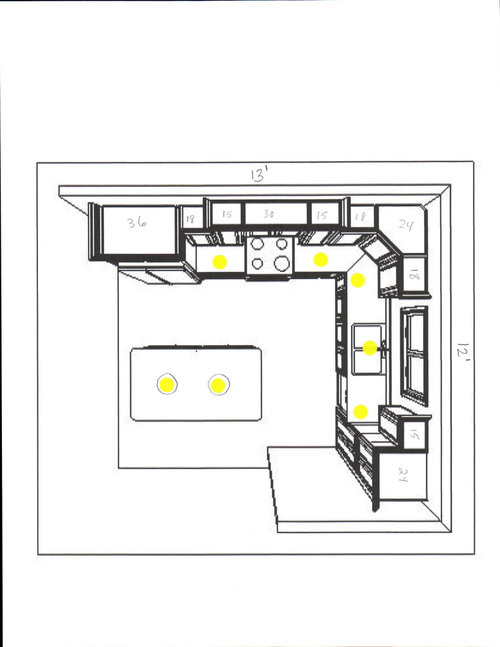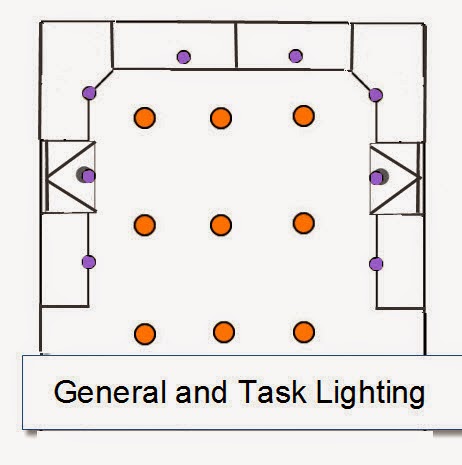

In the living room, it’s ideal to use 2-inch and 3-inch trims and 400 to 800 lumens per light.Eyelid recessed lights can highlight art or photographs of the family.Make sure trims are suitable for wet locations. Choose 700 to 1200 lumens per light, with a 2700K to 3000K color temperature and 2-inch to 3.5-inch trims. In the bathroom, you’ll need high ambient lighting.Make sure your lighting is wet listed, meaning they’re able to function in wet or moist environments.The dining room typically requires modern ambient light levels, so you’ll want to use 600 to 1000 lumens per light, with 2700K to 3000K and a 2-inch to 4-inch trim.Use dimmer control to set the ambiance to your desired level. Use a 3-inch to 4-inch trim and a narrow beam spread to help see recipes and assist with cooking and meal prep. The kitchen needs high ambient light, so pick 700 to 1200 lumens per light, with a 2700K to 3000K color temperature.Choose 4 or 5-inch lights to illuminate meal preparation and clean up properly.What are the best locations for recessed lighting? Kitchen What sizes of recessed lights are available?Ĥ-inch and 5-inches are perfect in kitchens, for overhead countertop lighting.Ħ-inch is usually present in general lighting scenarios.ħ-inch to 9-inch feature a wider beam of light. MR16 lamps are ideal for accent lighting. The R lamp is used as spot, flood, and display lights. The A-lamp is the most common type of lamp. What are the best sizes and types of bulbs to use in a recessed light? While there are trim accessories and housings if you want them (for new construction), most retrofit downlights are integrated fixtures, meaning the housing, trim, and lamp are included. Not all recessed downlights require you to buy your housing, trim, and lamp separately. The trim is visible to anyone in the room gives the light its aesthetic. It’s made up of the light source, mounting, and electrical parts. The housing is the part of the lighting that’s put into the ceiling, wall, or ground. What are the different parts of a recessed light? Excellent for highlighting artwork on walls.Features directional light, suitable for task lighting.Perfect for above the bathtub and shower stalls in bathrooms.Wet listed to prevent any moisture from seeping inside.Blends into a bathroom with a neutral design.

Ideal for sloped ceilings or accent walls.Downlight is able to be directed where needed.Allows the direction of light to be controlled using a pivot.Best suited for kitchens and rooms with high ceilings.Light beams are intensified, causing a brighter light.Recommended for living rooms and entryways.Perfect for emitting a softer glow, while helping to reduce eye strain.Features large grooves that absorb excess light and reduce glare.

What are the primary recessed lighting trim types? Baffle Trim These days, recessed lights come in a wide variety of trim styles and colors that can match your décor. They are most often used to make a room feel bigger, or as focal point lighting in kitchens, bar areas or over fireplaces, and are great for low ceiling heights. You might know them as can lights or puck lights, but recessed lights are those that are installed into ceilings and walls and usually designed to sit flush so the electrical housing is hidden. What are the main types of recessed lighting? The trim is part of the fixture that is visible to anyone.

The housing, which contains all of the electrical components, is hidden within the wall. It’s made up of three different components: the housing, the trim, and the bulb. Recessed lighting, also commonly known as can lights or downlights, are is typically installed inside a ceiling, wall, or other surface. In sum, your life’s about to get a lot easier. In it, we’ll talk about exactly what recessed lighting is, the different types of recessed lighting, its components, lamps, sizes, best locations, and more. We made this guide to help make your recessed lighting journey as pain-free as possible.


 0 kommentar(er)
0 kommentar(er)
